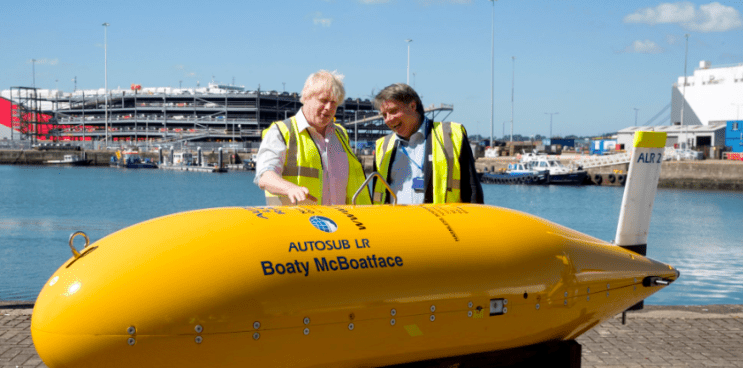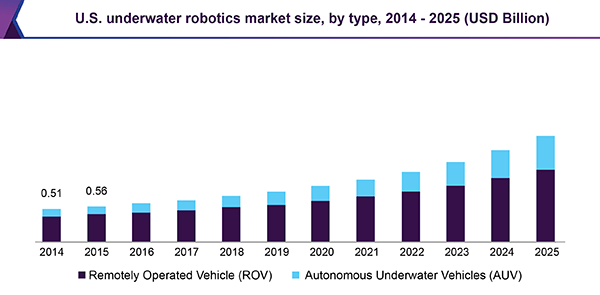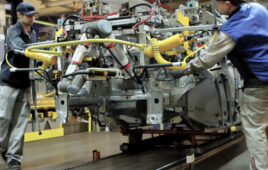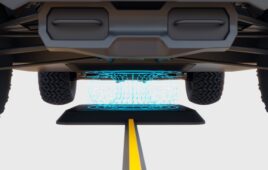The biggest mystery in the universe could possibly be right here on Earth. According to the National Oceanic and Atmospheric Administration (NOAA), as much as 95% of the oceans and 99% of the ocean floor has yet to be explored. Given more than 70% of the planet is covered by water, the promise for unmanned systems to go deeper into the depths of the sea could be one of the ripest opportunities for autonomy. Besides the benefits for conservationism, commercial missions are estimated to drive billions of dollars of new revenues. Already the demand for such hardware systems accounts for more than $2 billion, which many project will climb to more than $6 billion by 2025.
Today’s underwater drone market is in its infancy with most sensor-packed, torpedo-like devices being tugged around the globe on the decks of ships. These products break down into two main categories:
- Remote Operated Vehicles (ROV)
- Autonomous Underwater Vehicles (AUV)
As an example of the emerging possibilities for AUVs, earlier this month the British government-backed project, Boaty McBoatface, traversed more than 112 miles autonomously at depths of 4,000 meters to shed new light on climate change and rising sea levels.
In the words of Dr. Eleanor Frajka-Williams of the National Oceanography Centre in Southampton, England, “the data from Boaty McBoatface gave us a completely new way of looking at the deep ocean – the path taken by Boaty created a spatial view of the turbulence near the seafloor.” Frajka-Williams anticipates that the information will help scientists predict the impact of global warming.
Dr. Povl Abrahamsen of the British Antarctic Survey in Cambridge, England echoed this view, “This study is a great example of how exciting new technology such as the unmanned submarine ‘Boaty McBoatface’ can be used along with ship-based measurements and cutting-edge ocean models to discover and explain previously unknown processes affecting heat transport within the ocean.” The future plans for Boaty include diving underneath Arctic ice and into subsea volcanos.
Boaty operates in a crowded space of close to fifty for-profit companies competing for marketshare. The activities of both large multinational corporations and upstart technology providers range from applications for defense to commercial exploration to scientific research. One of the largest purveyors is BlueFin Robotics, which was purchased by General Dynamics in 2016. Since then, there have been a number of high profile aquatic acquisitions, including: Riptide Autonomous Solutions by BAE Systems; Liquid Robotics by Boeing; and multiple investments in Ocean Aero by Lockheed Martin. The biggest driver of this consolidation is the demand from the military, particularly the Navy, for autonomous searching out and destroy missions.
In September 2017 the US Navy established the Unmanned Undersea Vehicle Squadron 1 (UUVRON-1). When explaining this move, Captain Robert Gaucher stated “Standing up UUVRON 1 shows our Navy’s commitment to the future of unmanned systems and undersea combat.” This sentiment was shared by Commander Corey Barker, spokesman of the famed Submarine Force Pacific, “In addition to providing a rapid, potentially lower cost solution to a variety of mission sets, UUVs can mitigate operations that pose increased risk to manned platforms.”
Last summer the Navy appointed a dedicated Commander of UUVRON-1, Scott Smith. In a recent interview, Smith opined his vision for sea drones, “Those missions that are too dangerous to put men on, or those missions that are too mundane and routine, but important ― like monitoring ― we’ll use them for those missions, as well. I don’t think we’ll ever replace the manned platform, but we’ll certainly augment them to a large degree.” It is this augmentation that is generating millions of dollars of defense contracts which are starting to spill over to private industry.

Boston-based Dive Technologies, founded by a team of former BlueFin engineers, is building an innovative technology to broaden the use of unmanned marine systems. In speaking with its CEO this week, Jerry Sgobbo, he described nascent opportunities for his suite of innovations: “We see demand for offshore survey work in the U.S. increasing significantly as grid scale offshore wind farms are developed over the next decade. In particular, much of this work will take place in New England and mid-Atlantic waters.”
Sgobbo is referring to the recent move by Rhode Island in constructing the first ever wind farm in the United States, capitalizing on the regions famous gale-force gusts. Based upon the success of the Block Island project, other states are quickly putting forth legislation to follow suit. Just this week, Senator Edward Markey of Massachusetts declared in Congress that “offshore wind has the potential to change the game on climate change, and those winds of change are blowing off the shores of Massachusetts. Offshore wind projects are a crucial part of America’s clean energy future, creating tens of thousands of jobs up and down the East Coast and reducing carbon pollution. In order to harness this potential, we need to provide this burgeoning industry the long-term certainty in the tax code that it needs.”
Sgobbo believes that such moves will spark greater investment in automation to support the harnessing of renewal energy. Dive’s value proposition is collecting imaging that enables wind farm builders to better map the ocean floor for their large structures. As the founder states, “For commercial customers, this data is necessary to support deepwater energy infrastructure projects. For defense customers, the same imaging approach is used to locate sea mines.”
Dive’s flexible platform readily lends itself to the development of offshore wind turbines. Sgobbo further explained, “Dive’s AUV is a large platform with very long range and is intended to operate independently without the need for the infrastructure that traditionally supports an AUV mission today. This allows a survey operator to reduce cost as well as perform survey work at times of the year when it is impractical to use a towed system or smaller AUV.”

The startup leveraged its extensive industry knowledge to reinvent how marine drones are utilized. “When we started Dive Technologies, my co-founders and I first took an in-depth look at how medium and large sized AUVs are being operated and manufactured across the industry today and we saw vast potential for innovation and improvement,” recalled Sgobbo. “Our new AUV platform, the ‘DIVE-LD,’ addresses the industry’s needs by drastically increasing payload capacity and on-board energy storage but, most importantly, driving down the cost to collect offshore data. We do this by offering quickly configurable payload space to accommodate specific sensors needed for a job or mission, and then letting our robot do what robots are meant to do, operate autonomously and with minimal human intervention.”
This means that Dive’s ability to tailor its product to specific mission requirements, along with greater battery capacity, enables it to take travel farther and deeper than its competitors. “Today’s offshore AUV missions are typically conducted with a dozen humans in an expensive surface support vessel which leads to important survey work being prohibitively expensive. Dive’s novel engineering solution will categorically shift this paradigm,” expounds Sgobbo.
As the growth of marine robotics begins to proliferate across the globe, how businesses utilize the technology will expand into new categories. Sgobbo predicts, “Often, the military and commercial missions have used very similar AUV technology, but are looking for different things in the ocean. Looking forward, both customers are interested in longer range AUVs. For commercial customers, the goal is to reduce operating costs. For defense, a low cost, long range AUV opens new mission sets beyond mine countermeasure and will further lend to keeping sailors safe from dull, dirty, and dangerous missions. Also, AUVs are increasingly important data collection tools for the scientific community.”
As we closed our discussion, he optimistically quipped, “With approximately 90% of the world’s trade carried across these marine highways, we see the U.S. Navy investing heavily in next generation AUV technologies to maintain a forward presence and keep shipping lanes secure. As a team, we also look forward to the opportunities we’ll discover in the unknown.”






Tell Us What You Think!